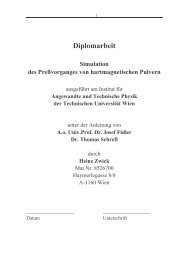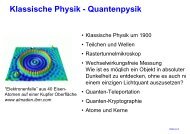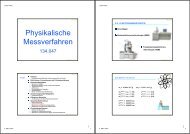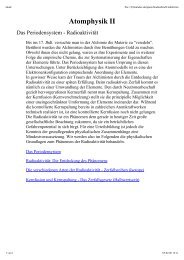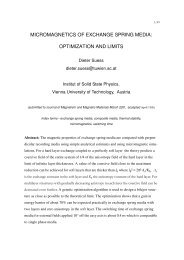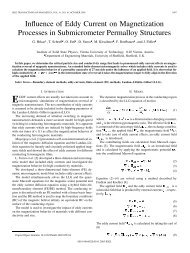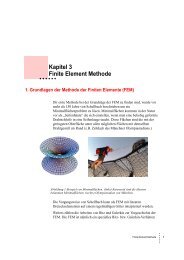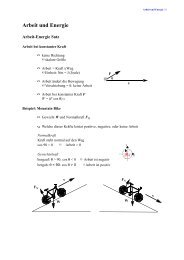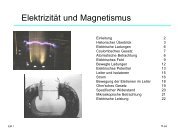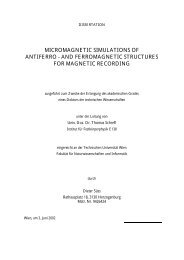PDF Full-Text - Research Group Fidler
PDF Full-Text - Research Group Fidler
PDF Full-Text - Research Group Fidler
- No tags were found...
Create successful ePaper yourself
Turn your PDF publications into a flip-book with our unique Google optimized e-Paper software.
Plant and Soil (2005) 271: 205–218 Ó Springer 2005DOI 10.1007/s11104-004-2387-5Changes of Ni biogeochemistry in the rhizosphere of the hyperaccumulatorThlaspi goesingenseMarkus Puschenreiter 1 , Andrea Schnepf 1,2 , Ine´s Molina Milla´n 1 , Walter J. Fitz 1 ,Othmar Horak 3 ,Ju¨ rgen Klepp 4 , Thomas Schrefl 4 , Enzo Lombi 5 & Walter W. Wenzel 1,61 Department of Forest and Soil Sciences, University of Natural Resources and Applied Life SciencesVienna, Gregor Mendel Strasse 33, A-1180 Vienna, Austria.2 Department for Water, Atmosphere andEnvironment, University of Natural Resources and Applied Life Sciences Vienna, Muthgasse 18, A-1190Vienna, Austria. 3 Austrian <strong>Research</strong> Center Seibersdorf, Department of Environmental <strong>Research</strong>, A-2444Seibersdorf, Austria. 4 Institute of Solid State Physics, Vienna Technical University, Wiedner Hauptstraße8-10, A-1040 Vienna, Austria.5 CSIRO Land and Water, PMB2 Glen Osmond, SA 5064, Australia.6 Corresponding author*Received 3 March 2004. Accepted in revised form 23 August 2004Key words: hyperaccumulation, modeling, nickel, rhizobox, rhizosphere, Thlaspi goesingenseAbstractProcesses in the rhizosphere of metal hyperaccumulator species are largely unknown. We investigatedroot-induced changes of Ni biogeochemistry in the rhizosphere of Thlaspi goesingense Ha´la´csy in a rhizoboxexperiment and in related soil chemical and Ni uptake studies. In the rhizobox, a root monolayerwas separated from rhizosphere soil by a nylon membrane. Rhizosphere soil was then sliced into0.5 mm layers and analyzed for changes in soluble (water-extractable, Ni S ) and labile (1 M NH 4 NO 3 -extractable, Ni L ) Ni pools. Ni L in the rhizosphere was depleted due to excessive uptake in T. goesingense.Ni S in the rhizosphere increased in contrast to expectations based on the experimental Ni desorptionisotherm. Mathematical simulations following the Tinker–Nye–Barber approach overestimated thedepletion of the Ni L and predicted a decrease of Ni S in the rhizosphere. In a hydroponic experiment, wedemonstrated that T. goesingense takes up Ni 2+ but excludes metal–organic complexes. The model outputwas then improved in later versions considering this finding. A sensitivity analysis identified I maxand K m , derived from the Michaelis–Menten uptake kinetics experiment to be the most sensitive of themodel parameters. The model was also sensitive to the accuracy of the estimate of the initial Ni concentration(C Si ) in soil solution. The formation of Ni–DOM complexes in solution could not explain thepoor fit as in contrast to previous field experiments, the correlation between soluble Ni and dissolvedorganic carbon (DOC) was weak. Ion competition of Ni with Ca and Mg could be ruled out as explanationof enhanced Ni solubility in the rhizosphere as the molar ratio of Ni/(Ca + Mg) in solution wasnot affected. However, a decreased Vanselov coefficient Kv near the root plane indicated (an apparent)lower selectivity of the exchange complex for Ni, possibly due to adsorption of oxalate exuded by T.goesingense roots or associated rhizosphere microbes. This conclusion is supported by field data, showingenhanced oxalate concentrations in the rhizosphere of T. goesingense on the same experimental soil.The implications for phytoextraction and bio-available contaminant stripping (BCS) as well as for futuremodeling and experimental work are discussed.* FAX No: +43-1-47654-3130.E-mail: walter.wenzel@boku.ac.at
206Abbreviations: C L – simulated concentration of labile (adsorbed + soluble) Ni in soil; C S – simulated Niconcentration in soil solution; DOC – dissolved organic carbon; Ni L – measured labile (adsorbed+soluble)Ni in soil; Ni S – measured water-extractable Ni in soilIntroductionHyperaccumulator plants are able to take uplarge amounts of metals and store them in theiraerial plant tissues without showing symptoms oftoxicity (Baker and Brooks, 1989). These plantshave attracted the interest of plant and soil scientistsbecause of their potential in the developmentof phytoremediation technologies for the treatmentof metal-polluted soils, sediments and waterresources (McGrath and Zhao, 2003; Wenzelet al., 1999a). Some well studied hyperaccumulatorplants belong to the genus Thlaspi of theBrassicaceae family, including the Ni hyperaccumulatorThlaspi goesingense Ha´la´csy, whichgrows indigenously on serpentine sites in Austria(Reeves and Baker, 1984). This plant can serveas a model plant to study the phytoextractionprocess and was used in this investigation.Phytoremoval of labile, bioavailable metalpools (bioavailable contaminant stripping – BCS)has been considered as an alternative to phytoextractionbased on total metal concentrations insoil (Fitz et al., 2003a; Hamon and McLaughlin,1999). Biogeochemical processes in the rhizosphereof hyperaccumulators such as metalreplenishment from less available metal pools arecritical for the success of BCS (Wenzel et al.,1999b) and have recently been demonstrated forthe arsenic hyperaccumulator Pteris vittata L.(Fitz et al., 2003a). Excessive metal uptake hasbeen found to be associated with partial depletionof labile, easily bio-accessible metal pools inthe rhizosphere (e.g., Fitz et al., 2003a; Hammerand Keller, 2002; Puschenreiter et al., 2003;Whiting et al., 2001a, b) and active root proliferationtowards contaminated soil areas (Schwartzet al., 1999). Even though depletion of labilemetal pools in the rhizosphere of hyperaccumulatorplants often has been found to be associatedwith sustained or even enhanced solubility (i.e.soil solution concentration) direct evidence formobilization of metals, either due to acidification(Bernal et al., 1994; Li et al., 2003; McGrathet al., 1997) or induced by root exudation (Saltet al., 2000; Zhao et al., 2001) has not beenreported so far. In recent field surveys of T. goesingensegrowing on indigenous serpentine soil,increased water-extractable Ni concentrations inthe rhizosphere were found to be associated withincreased DOC and siderophore-producing rhizospherebacteria, suggesting that root and/ormicrobial exudates may be involved in Ni mobilization(Idris et al., 2004; Wenzel et al., 2003).Rhizobox systems have been used by variousauthors to study root-induced changes of soil properties.Due to a number of shortfalls of previous systems,a new rhizobox design was developed byWenzel et al. (2001), which allows determination ofgradients of rhizosphere characteristics at high spatialresolution. The data obtained in such experimentscan be used to validate rhizosphere models.Single root models have been used to simulateuptake and concentration gradients in the rhizosphereof solutes, such as K, P, Mg and Cd (Kirk,1999; Kirk and Staunton, 1989; Syring and Claasen,1996). These models are based on solute transporttheory and should be applicable to the simulation ofNi in the rhizosphere of T. goesingense. A validatedexplicative model is intended to identify/understandfundamental mechanisms underlying the behavior ofthe system (Saltelli et al., 2000).The objective of this study was to investigatehighly resolved gradients of soluble and labile Nipools and associated biogeochemical changes inthe rhizosphere of the Ni hyperaccumulator T.goesingense in a rhizobox experiment and inrelated soil chemical and plant uptake assays.For quantitative interpretation, the experimentaldata were compared to simulations adoptingthe approaches of Barber (1995), Syring andClaassen (1996) and Tinker and Nye (2000). Substantialchanges to these model approaches wereoutside the scope of this work.Materials and methodsSoil and plant materialSeeds of Thlaspi goesingense Ha´la´csy and theultramafic soil used in this experiment were
207obtained from a serpentine site near Redlschlag,Austria (Wenzel et al., 2003). Fresh soil waspassed through a 2-mm stainless steel mesh andstored in a freezer ()20 °C). The soil had a pHof 6.55 and the total metal and nutrient concentrations,determined by digestion in aqua regiafollowed by ICP-OES analyses, were (inmg kg )1 ): Ca, 552; Cr, 466; K, 478; Mg, 46,400;Na, 180; Ni, 2080; Zn, 27.7.Rhizobox experiment and related analysesThe experiment was conducted in 10 replicatesusing a rhizobox system developed and evaluatedby Wenzel et al. (2001).Seeds were germinated directly in the soil (15seeds per box), and seedlings were pre-grown inthe upper soil–root compartment of the rhizobox.Ten days after germination, plant density wasreduced to 8 plants per box. Seventy days aftersowing, the plant–soil compartments were transferredonto the rhizoboxes containing the samesoil adjusted to a bulk density (q) of 1150 kg m )3 .The water content of the rhizosphere soil wasadjusted to 240–375 g kg )1 (29–45% of waterholding capacity). One day later the upper fringesof the root compartment slits were slightly openedby 1 mm. Roots entered the root-only compartmentthree to five days later. The root-only compartmentcontains no soil and is a small slitseparated from rhizosphere soil by a nylon membraneand an acrylic window that allows for visualcontrol and documentation of root growth(Wenzel et al., 2001). The nylon membrane usedfor separating roots from soil had a mesh size of7 · 25 lm, allowing the penetration of root hairs(2–6 lm diameter, 800 lm length) through themembrane. After 32 days, the experiment was terminatedand six rhizoboxes showing similar rootdevelopment were chosen for analysis.The soil compartments were separated fromthe membrane and frozen prior to slicing in0.5 mm layers (between 0 and 2 mm distancefrom the roots) or 1 mm layers (between 2 and5 mm distance from the roots). Slicing was performedparallel to the root plane using a refrigeratedmicrotome (Zeiss, with modifications). Atrim thickness of 0.5 mm was chosen to minimizepotential artifacts (Fitz et al., 2003b). In a separatestudy, it was found that freezing and thawingchanged the labile Ni fraction by
208MgCl 2 as background electrolyte (30 min shaking;end-over-end). We used a soil : solution ratioof 1:5 (m/v) because although the difference to asaturation extract type isotherm was small(
209convection. Phytoavailable Ni was assumed to bepresent in two soil phases: the soil solution (Ni S )and the exchangeable pool (Ni L ) that reacts withNi S in an instantaneous quasi-equilibrium reaction.Uptake by root and root hairs was assumedto follow Michaelis–Menten kinetics (Barber,1995). The steady-state solution of Tinker andNye (2000) for the flux into a cylindrical rootwas used to approximate Ni influx into roothairs, assuming the same uptake properties as forroots. The uptake by root hairs was optionallyintroduced into the model as an additional sinkterm (Tinker and Nye, 2000).The input parameter values (Table 1) wereobtained experimentally or adopted from the literature.The water flux density J w [m s )1 ] wasderived from the measured loss of water in thereservoir that was connected to the rhizospherecompartment via glass fiber strips (Wenzel et al.,2001).The diffusion coefficient of Ni in free solutionD w was estimated using average literature data(Lide, 2000). The tortuosity factor f [–] was calculatedusing the empirical relationf ¼ 0:16 h 0:172; ð2Þwhere h [–] was the average volumetric watercontent measured in the rhizoboxes (Barber,1995).A composite Freundlich isotherm was fittedto the experimental data obtained in the desorptionexperiment because a single non-linearFreundlich isotherm did not result in a satisfactoryfit. The data were split into two branches ofdifferent slopes. Each branch was fitted using theequationC a ¼ K f C m S þ d;ð3Þwhere C a [lmol kg )1 ] is the concentration ofadsorbed Ni per unit mass of soil, C S [lM] isthe concentration of soluble Ni, and K f[lmol 1)m L m kg )1 ], m [–] and d [lmol kg )1 ] arethe parameters of the Freundlich isotherm. Theconstant d was introduced to improve the fit byallowing the curve to not pass through the origin(Syring and Claassen, 1996). Note that this constantdid not influence the simulated solutionconcentration as the model used only the derivativedC a /dC S .The effective diffusion coefficient D e was calculatedby the model according to the relationTable 1. Input parameter values used for the mathematical model to calculate Ni behavior in T. goesingense rhizosphere.Parameter type Symbol Notation ValueTransport parameters J w [m s )1 ] Water flux density 3.73E)07D w [m 2 s )1 ] Diffusion coefficient in water 6.16E)07h [–] Volumetric water content 0.36f [–] Impedance factor 0.40q[kg m )3 ] Bulk density 1150Sorption parameters for labilepoolm [–] Freundlich isotherm if C S 1.19–2.21 then 0.12else 0.60K f [lmol 1)m L mkg )1 ]Freundlich isotherm if C S 1.19–2.21 then 3730else 503d [lmol kg )1 ] Freundlich isotherm if C S 1.19–2.21 then )2790else 0Root hair parameters r rh [m] Root hair radius 5.00 E)6l rh [m] Loot hair length 8.00 E)4n rh [m )1 ] Number of root hairs per unit root length 1 E4–5 E4Uptake kinetics a [m 2 m )3 ] Root hair surface area per unit volume of soil 1000–2500K m [lM] Michaelis–Menten constant 36.1I max [lmol m )2 h )1 ] Maximum influx rate 28.0Initial conditions C Si [lM] Initial Ni concentration in soil solution 4.26*2.21**C Li [lM] Initial concentration of labile Ni in soil 252*Calculated using Equation (5) (Altfelder et al., 2001).**Determined in soil solution obtained with micro-suction cups.
210Table 2. Results of a hydroponic experiment on the uptake of Ni species by T. goesingense.Temperature nmol Ni g )1 root h )1 Standard error D 20–4 °C5 lM Ni solution20 °C 83.3 15.4 44.34 °C 39.1 8.635 lM Ni+5 lM histidine solution20 °C 55.7 12.8 20.44 °C 35.4 3.19The experiment had 3 replicates. Adding equimolar (5 lM) histidine to the Ni solution reduced activityof Ni 2+ by half. Subsequently, also Ni uptake by T. goesingense was decreased in similar extent.D e ¼ D w hf =ðqK f þ hÞ:ð4ÞThe parameters for the Michaelis–Menten kinetics,I max [lmol m )2 h )1 ] and K m [lM] wereobtained by fitting the equation to the Ni uptakerate data measured in the solution culture experimentwith T. goesingense. Nickel uptake characteristicswere assumed to be the same for rootsand for root hairs. Planar geometry was chosenin accordance with the planar root mat developedin the rhizobox experiment. As only 60% of theroot plane in the rhizobox was covered by roots,all fluxes across the membrane were related to 0.6times its area. For converting the Ni uptake ratebased on root mass to root surface area, the ratioroot surface area:root fresh weight was determinedto be 106 cm 2 g )1 . Root surface area wasestimated from root morphological characteristicsof naturally growing T. goesingense plants sampledat the site near Redlschlag using the imageanalysis approach (Himmelbauer et al., 2003).Root hair characteristics were estimated for fieldgrown plants using a microscope.As Ni speciation is not calculated by themodel, it was treated as an additional inputparameter in the extended model. Assuming equilibrium,measured pH and total ion concentrationsof Ni, Ca, Mg, K, SO 4 , Cl, NO 3 and DOCin the water extracts (Table 3) were used to calculatethe chemical speciation of Ni using thePRODEFA2/MINTEQA2 software package (Allison,1991). Measured DOC concentrations inthe water extract were converted to molar siteconcentrations of reactive functional groupsTable 3. Input variables for the calculation of Ni speciation using the software package MIN-TEQA2/PRODEFA2 (Allison et al., 1991) and resulting output.Parameter Unit Bulk soil 0–0.5 mmInputPH 7.44 7.65Ca S lM 11.0 16.0K S lM 13.1 16.4Mg S lM 177 220Na S lM 56.5 67.0Ni S lM 0.61 0.89Cl S lM 42.9 47.6NO 3 lM 98.8 121SO 4 lM 2.40 3.70DOC lM 78.0 103OutputNi 2+ /Ni S [–] 0.44 0.42Ni–DOC/Ni S [–] 0.56 0.58(anions)cations) / (anions+cations) % 5.1 3.9Ion activities were calculated using Davies equation, the molar site concentration of DOC usingan average site density of 5 lmol mg )1 DOC according to Wenzel et al. (1996).
214Table 4. Results of the sensitivity analysis showing the effectof changing parameter values on model output expressed byRMSE (root mean squared error) and NRMSE (normalizedroot mean squared error) between original output of the basicmodel and output after variation of parameters.RMSENRMSEI max /2 0.97 0.45I max /5 1.60 0.75I max *2 1.07 0.50K m /2 1.07 0.50K m *2 0.94 0.44K m *5 1.58 0.74I max /2, K m *2 1.48 0.69C Si = 2.21 lM 0.50 0.25D e /2 0.54 0.25D e *2 0.48 0.23(a)Ni S :Ni Si or C S :C Si [-]1.51.00.50.00 1 2 3 4 5distance from root surface [mm]extended modelextended model; I max /22003). Metal depletion in the rhizosphere hasalso been reported for the Zn hyperaccumulatorThlaspi caerulescens (Hammer and Keller, 2002;Puschenreiter et al., 2003; Whiting et al., 2001a,b), for the Tl hyperaccumulator Iberis intermedia(Al-Najar et al., 2003) and for the As hyperaccumulatorPteris vittata (Fitz et al., 2003a) grownon contaminated soil. The data presented hereare the first to show the highly resolved gradientof depletion across the rhizosphere of a Ni hyperaccumulator.The models were able to reproducethe general trend but overestimated thedepletion of Ni L in the rhizosphere. The bestmatch of experimental data was obtained withthe extended model where only Ni 2+ is consideredto be taken up by the plant.A sensitivity analysis was performed to determinethe influence of variation of input parameterson the model output (Table 4). I max was found tobe the most sensitive parameter. Reducing I maximproved the fit to the measured data near theroot plane but still could not reproduce the shapeof the gradient of experimentally determined Ni L .Therefore, problems associated with the applicationof the short-term data obtained in hydroponicconditions (Delgado and Amacher, 1995; Mullinsand Edwards, 1989; Rengel, 1993) to simulate thelong-term uptake of Ni from real soil may contributeto the overestimation of Ni depletion but cannot fully explain the deviation. The conversion ofI max based on root fresh mass to surface area mayhave introduced additional uncertainty.(b)∆ Ni L or ∆ C L [mmol m -3 soil]0-100-200-300extended model; I max /5extended model; C Si = 2.21 µMmeasured data0 1 2 3 4 5distance from root surface [mm]Figure 4. Sensitivity analysis for the parameters I max and C Siand its effect on the gradient of Ni S and C S (A) and Ni L andC L (B) in rhizosphere. The relative concentration of solubleNi is expressed as the ratio of N S :N Si and C S :C Si .The accuracy of the estimate for the initial Niconcentration C Si seems to be equally importantfor the quality of the model output. Using measuredsoil solution data was clearly superior toEquation (4), which overestimated the initial Niconcentration in soil solution. As a consequence,uptake in T. goesingense and the resulting depletionof Ni in the rhizosphere was overestimatedas the rate of uptake depends on the Ni concentrationin soil solution (Figure 2B).
215Nickel in soil solution (Ni S )According to the desorption isotherm (Figure2A), the observed depletion of Ni L should bereflected by a corresponding decrease of Ni S .Ina well-buffered soil, one may expect sustained ionconcentrations if the rate of replenishmentexceeds the rate of ion removal by the plant. SustainedAs concentrations in the soil solution ofAs hyperaccumulator Pteris vittata grown on awell buffered soil have been reported by Fitzet al. (2003a). However, our experimental datashow even increased soluble Ni in the rhizosphereof T. goesingense, confirming previousfield observations (Wenzel et al., 2003). None ofthe model versions were able to reproduce thistrend. On the contrary, all simulations predicteda decrease of Ni S in the rhizosphere. Thisincrease of Ni S can not be related to the observedslight increase in rhizosphere pH (Figure 1E)because Ni solubility is expected to decrease withincreasing pH (Bru¨ mmer et al., 1986).In our previous field study (Wenzel et al.,2003) we found a highly significant correlationbetween Ni and DOC in soil solution(R 2 ¼ 0.85), providing evidence for enhanced formationof Ni–DOM complexes in the rhizosphereof T. goesingense. In the rhizoboxexperiment, the correlation with DOC was weak(R 2 ¼ 0.25, P ¼ 0.05) and can not satisfactorilyexplain the gradient of Ni S .Ion competition with Mg and Ca can be alsoruled out as explanation of increased Ni solubilityin the rhizosphere because the molar ratio ofsoluble Ni/(Ca + Mg) was not altered in thevicinity of the root plane (Figure 1G).To further investigate the interaction of Niwith Ca and Mg, we calculated the Vanselowcoefficient K V (Vanselow, 1932). The observeddecrease of K V towards the root plane (Figure1H) can be interpreted as decreased selectivityof the exchange complex for Ni, possiblyinduced by adsorbed organic acids derived fromroot/microbial exudates. Strong adsorption (typically> 80% of the amount released into the rhizosphere)of oxalate onto soil minerals is knownfrom previous studies (Jones and Brassington,1998; Jones et al., 2003). Due to the smallamounts of soil obtained in the rhizobox experimentwe could not determine individual organicacids. However, in recent field work at the sitenear Redlschlag (unpublished data) we foundincreased solute concentrations of oxalic (+20%)and citric acid (+243%) in the rhizosphere ofT. goesingense relative to the bulk soil.Adsorption of organic ligands onto surfaces ofNi-bearing primary minerals (e.g. forsterite) andligand-promoted dissolution of Ni has been suggestedby Wenzel et al. (2003) to explainenhanced Ni solubility in the rhizosphere of T.goesingense in a field survey. Like in the rhizoboxexperiment, the increased Ni solubility was associatedwith depletion of the labile (adsorbed) Nifraction in the rhizosphere. The change of K Vobserved in our rhizobox experiment may partlybe a consequence of altered mineral surfacesresulting from the ligand-promoted dissolution ofNi, Ca and Mg. Note that in the rhizobox experimentsoluble Ca and Mg in the rhizosphere wereincreased similar to Ni S (Figure 1B), whereas thelabile fractions of these elements were depleted(Figure 1D). This indicates additional replenishmentfrom sources other than the adsorbed orexchangeable fractions. The concomitant increaseof Ni, Ca and Mg concentrations in solutioncould be explained by enhanced dissolution ofNi-bearing silicates such as forsterite in theT. goesingense rhizosphere (Wenzel et al., 2003).Based on these considerations, the interactionsof organic acids released by T. goesingense rootswith the soil solid phase appear to be among thekey processes that need to be addressed in futuremodeling and related experiments.The improved match of experimental data bymodel versions considering only Ni 2+ for uptakein T. goesingense demonstrates the importance ofNi speciation in soil solution. However, the formationof Ni–DOM complexes in soil solutioncan not fully explain the results of the rhizoboxexperiment, stressing the possible role of organicligand – soil solid phase interactions in the rhizosphereof T. goesingense. Related processes suchas adsorption of organic acids and ligand-promotedmineral dissolution need to be included inmodels aimed at understanding the biogeochemistryof metals in the rhizosphere of Ni hyperaccumulatingplants.Ni uptake in T. goesingenseIn the second hydroponic experiment weobserved that T. goesingense takes up free Ni 2+
216rather than a Ni chelate complex. This confirmsprevious observations on Brassica juncea L.(Kerkeb and Kra¨ mer, 2003) and is in accordanceto the free ion model of Parker and Fiedler(1997). The importance of considering the effectof chemical speciation on the uptake of metals inhyperaccumulator plants is demonstrated by thesecond hydroponic experiment. As discussedabove, this observation had large impact on themodel output. We conclude that the kinetics ofNi uptake needs further attention in terms ofexperimental approaches and modeling. It iscommon to use data obtained in short-termhydroponic experiments to simulate ion uptakein model exercises (e.g., Delgado and Amacher,1995; Kirk, 1999), but future work shouldexplore alternative approaches.Implications for phytoextraction/bioavailablecontaminant strippingThe success of phytoextraction of metals dependson their accessibility to the roots of the phytoextractingcrop. Depletion of bio-accessible metalfractions due to excessive uptake may reduce theuptake rate during the phytoextraction process.The deviations between the simulations and therhizobox experiment reveal the general importanceof root – soil interactions in the rhizosphere ofphytoextraction crops. In particular, our resultssuggest that root activities such as the exudationof organic acids triggered the replenishment of solubleNi from sources other than the adsorbed fractionthrough interactions with the soil solid phase(e.g., ligand-promoted dissolution of Ni from forsterite-typeminerals). This aspect has not receivedsufficient attention in previous work, but may be akey to understand and predict rates of metal phytoextractionin the long-term. The emphasis ofresearch on hyperaccumulation and phytoextractionhas been on plant processes (e.g. Assunça˜ oet al., 2003; McGrath and Zhao, 2003). However,the design and duration of phytoremediation technologieswill also depend on related soil and rhizosphereprocesses.A critical aspect of conventional phytoextractionis the time needed to lower the total metalconcentration in soil below a certain target value(McGrath and Zhao, 2003). Bio-availablecontaminant stripping (BCS; Hamon andMcLauglin, 1999) could substantially reduce thetime required as only bio-accessible fractions aretargeted in this process (Fitz et al., 2003a). Ourresults clearly show that it is not enough to monitorthe labile (1 M NH 4 NO 3 -extractable) fraction.Especially in contaminated soil, othersources such as minerals containing largeamounts of the target metal may contribute tosustained or even enhanced metal concentrationsin soil solution in spite of depleted labile fractions.This process can be triggered by root exudates.Future experimental and modeling workneeds to address these processes and to developsimple predictive tools for estimating the metalfractions in soil that could become bio-availablein the rhizosphere of BCS crops.AcknowledgementsWe are indebted to the Institute of Ecology andConservation Biology, Univ. of Vienna (Prof.H.R. Bolha´r-Nordenkampf, Dr Gert Bachmann),for providing greenhouse facilities. We thank DrGunda Ko¨ llensperger and Dr Katherina Kanitsarfor analysis of Ni by ICP-SFMS. We gratefullyacknowledge the financial support by theAustrian Science Foundation (FWF, P 13454),the Ministry for Education, Science and Culture(GZ38.038/1-VIII/A/4/2000) and by the BOKU –University of Natural Resources and AppliedLife Sciences, Vienna (BOKU Priority <strong>Research</strong>Area Project #16).ReferencesAllison J D, Brown D S, Novo-Gradac K J 1991 MINT-EQA2/PRODEFA2, a geochemical assessment model forenvironmental systems. Version 3.0 user’s manual. EPA/600/3-91/021. USEPA, Athens.Al-Najar H, Schulz R and Ro¨ mheld V 2003 Plant availabilityof thallium in the rhizosphere of hyperaccumulator plants:a key factor for assessment of phytoextraction. Plant Soil249, 97–105.Altfelder S, Streck T, Maraqa M A and Voice T C 2001 Nonequilibriumsorption of dimethylphthalate – compatibilityof batch and column techniques. Soil Sci. Soc. Am. J. 65,102–111.Assunção A G L, Schat H and Aarts M G M 2003 Thlaspi caerulescens,an attractive model species to study heavy metalhyperaccumulation in plants. New Phytol. 159, 351–360.Baker A J M and Brooks R R 1989 Terrestrial higher plantswhich hyperaccumulate metallic elements – a review oftheir distribution, ecology and phytochemistry. Biorecovery1, 81–126.
217Barber S A 1995 Soil Nutrient Bioavailability: A MechanisticApproach. John Wiley & Sons Inc., New York.Bernal M P, McGrath S P, Miller A J and Baker A J M 1994Comparison of the chemical changes in the rhizosphere ofthe nickel hyperaccumulator Alyssum murale with the nonaccumulatorRaphanus sativus. Plant Soil 164, 251–259.Brandstetter A, Sletten R S, Mentler A and Wenzel W W1996 Estimating dissolved organic carbon in natural watersby UV absorbance (254 nm). Z. Pflanzenernähr. Bodenk.159, 605–607.Bru¨ mmer G W, Gerth J and Herms U 1986 Heavy metal species,mobility and availability in soils. Z. Pflanzenernähr.Bodenk. 149, 382–398.Delgado J A and Amacher M C 1995 Modeling the uptake ofsulfur by crops on two alluvial soils of Louisiana: soybeans.Comm. Soil Sci. Plant Anal. 26, 1491–1505.Fitz W J, Wenzel W W, Zhang H, Nurmi J, Stipek K,Fischerova Z, Schweiger P, Ko¨ llensperger G, Ma L Q andStingeder G 2003a Rhizosphere characteristics of thearsenic hyperaccumulator Pteris vittata L. and monitoringof phytoremoval efficiency. Environ. Sci. Technol. 37,5008–5014.Fitz W J, Wenzel W W, Wieshammer G and Istenič B 2003bMicrotome sectioning causes artefacts in rhizobox experiments.Plant Soil 256, 455–462.Gray C W, McLaren R G, Roberts A H C and Condron LM 1998 Sorption and desorption of cadmium from someNew Zealand soils: Effect of pH and contact time. Aust. J.Soil Res. 36, 199–216.Hammer D and Keller C 2002 Changes in the rhizosphere ofmetal-accumulating plants evidenced by chemical extractants.J. Environ. Qual. 31, 1561–1569.Hamon R E and McLaughlin M J 1999 Use of the hyperaccumulatorThlaspi cearulescens for bioavailable contaminantstriping. In Proc. 5th International Conference on theBiogeochemistry of Trace Elements. Eds. W W Wenzelet al. pp. 908–909, Vienna.Himmelbauer M L, Puschenreiter M, Schnepf A, LoiskandlW and Wenzel W W 2003 Root morphological characteristicsof nickel hyperaccumulator Thlaspi goesingense. In Proceedingsof the 7th ICOBTE. Eds. G Gobran and N Lepp.pp. 180-181. SLU Service/Repro, Uppsala.Idris R, Trifonova R, Puschenreiter M, Wenzel W W andSessitsch A 2004 Bacterial communities associated withflowering plants of the Ni hyperaccumulator Thlaspi goesingense.Appl. Environ. Microbiol. 70, 2667–2677.Jones D L and Brassington D S 1998 Sorption of organicacids in acid soils and its implications in the rhizosphere.Eur. J. Soil Sci. 49, 447–455.Jones D L, Dennis P G, Owen A G, van Hees P A W 2003Organic acid behaviour in soils – misconceptions andknowledge gaps. Plant Soil 248, 31–41.Kerkeb L and Krämer U 2003 The role of free histidine inxylem loading of nickel in Alyssum lesbiacum and Brassicajuncea. Plant Physiol. 131, 716–724.Kirk G J D and Staunton S 1989 On predicting the fate of radioactivecesium in soil beneath grassland. J. Soil Sci. 40, 71–84.Kirk G J D 1999 A model of phosphate solubilization byorganic anion excretion from plant roots. Eur. J. Soil Sci.50, 369–378.Lasat M M, Baker A J M and Kochian L V 1996 Physiologicalcharacterisation of root Zn 2+ absorption and translocationto shoots in Zn hyperaccumulator and non-accumulator speciesof Thlaspi. Plant Physiol. 112, 1715–1722.Li Y M, Chaney R L, Brewer E P, Angle J S and Nelkin J2003 Phytoextraction of nickel and cobalt by hyperaccumulatorAlyssum species grown on nickel-contaminatedsoils. Environ. Sci. Technol. 37, 1463–1468.Lide D R 2000 Handbook of Chemistry and Physics, 83rdedition. CRC Press LLC, Boca Raton.McGrath S P, Shen Z G and Zhao F J 1997 Heavy metaluptake and chemical changes in the rhizosphere of Thlaspicaerulescens and Thlaspi ochroleucum grown in contaminatedsoils. Plant Soil 188, 153–159.McGrath S P and Zhao F J 2003 Phytoextraction of metalsand metalloids from contaminated soils. Curr. Op. Biotechnol.14, 1–6.McLaren R G, Backes C A, Rate A W and Swift R S 1998Cadmium and cobalt desorption kinetics from soil clays:effect of sorption period. Soil Sci. Soc. Am. J. 62, 332–337.Mullins G L and Edwards J H 1989 A comparison of twomethods for measuring potassium influx kinetics by intactcorn seedlings. J. Plant Nutr. 12, 485–496.Parker D R and Fiedler J F 1997 Reevaluating the free ionactivity model of trace metal availability to higher plants.Plant Soil 196, 223–228.Puschenreiter M, Wieczorek S, Horak O and Wenzel W W2003 Chemical changes in the rhizosphere of metal hyperaccumulatorand excluder Thlaspi species. J. Plant Nutr.Soil Sci. 166, 579–584.Reeves R D and Baker A J M 1984 Studies on metal uptakeby plants from serpentine and non-serpentine populationsof Thlaspi goesingense Halacsy (Cruciferae). New. Phytol.98, 191–204.Rengel Z 1993 Mechanistic simulation models of nutrientuptake: A review. Plant Soil 152, 161–173.Salt D E, Kato N, Krämer U, Smith R D and Raskin I 2000The role of root exudates in nickel hyperaccumulation andtolerance in accumulator and nonaccumulator species ofThlaspi. In Phytoremediation of Contaminated Soil andWater. Eds. N Terry and G Ban˜ uelos. pp. 189–200. CRCPress, Boca Raton.Saltelli A, Chan K and Scott E M 2000 Sensitivity Analysis.John Wiley & Sons Ltd., Chichester.Schnepf A, Schrefl T and Wenzel W W 2002 The suitabilityof pde-solvers in rhizosphere modeling, exemplified bythree mechanistic rhizosphere models. J. Plant Nutr. SoilSci. 165, 713–718.Schwartz C, Morel J L, Saumier S, Whiting S N and Baker AJ M 1999 Root development of the zinc-hyperaccumulatorplant Thlaspi caerulescens as affected by metal origin, contentand localization in soil. Plant Soil 208, 103–115.Shen Z G, Zhao F J, McGrath S P 1997 Uptake and transportof zinc in the hyperaccumulator Thlaspi caerulescensand the non-hyperaccumulator Thlaspi ochroleucum. Plant,Cell Environ. 20, 898–906.Syring K M and Claassen N 1996 Model of nutrient uptakeÓ NST 3.0. http://www.gwdg.de/uaac/.Tinker P B and Nye P H 2000 Solute Movement in the Rhizosphere.Oxford University Press, New York.Van Rees K C J, Comerford N P and Rao P S C 1990 Definingsoil buffer power: Implications for diffusion and nutrientuptake modeling. Soil Sci. Soc. Am. J. 54, 1505–1507.Vanselow A P 1932 Equilibria of the base-exchange reactionsof bentonites, permutites, soil colloids, and zeolites. SoilSci. 33, 95–113.Wenzel W W, Blum W E H, Brandstetter A, Jockwer F,Ko¨ chl A, Oberforster M, Oberländer H E, Riedler C, Roth
218K and Vladeva I 1996 Effects of soil properties and cultivaron cadmium accumulation in wheat grain. Z. Pflanzenerna¨hr. Bodenk. 159, 609–614Wenzel W W, Sletten R S, Brandstetter A, Wieshammer Gand Stingeder G 1997 Adsorption of trace metals by tensionlysimeters: Nylon membrane vs. porous ceramic cup.J. Environ. Qual. 26, 1430–1434.Wenzel W W, Adriano D C, Salt D E and Smith R 1999aPhytoremediation: A plant-microbe-based system. In Bioremediationof Contaminated Soils. Eds. Adriano D C,Bollag J-M, Frankenberger W T Jr and Sims R C. pp.457–510. SSSA Special Monograph no. 37, Madison.Wenzel W W, Lombi E and Adriano D C 1999b Biogeochemicalprocesses in the rhizosphere: Role in phytoremediationof metal-polluted soils. In Heavy Metal Stress in Plants:From Molecules to Ecosystems. Eds. Prasad M N V andHagemejer J. pp. 273–303. Springer, New York.Wenzel W W and Jockwer F 1999 Accumulation of heavymetals in plants grown on mineralised soils of the AustrianAlps. Environ. Pollut. 104, 145–155.Wenzel W W, Wieshammer G, Fitz W and Puschenreiter M2001 Novel rhizobox design to assess rhizosphere characteristicsat high spatial resolution. Plant Soil 237, 37–45.Wenzel W W, Bunkowski M, Puschenreiter M and Horak O2003 Rhizosphere characteristics of indigenously growingnickel hyperaccumulator and tolerant plants on serpentinesoil. Environ. Pollut. 123, 131–138.Whiting S N, Leake J R, McGrath S P and Baker A J M2001a Assessment of Zn mobilization in the rhizosphere ofThlaspi caerulescens by bioassay with non-accumulatorplants and soil extraction. Plant Soil 237, 147–156Whiting S N, Leake J R, McGrath S P and Baker A J M2001b Zinc accumulation by Thlaspi caerulescens from soilswith different Zn availability: A pot study. Plant Soil 236,11–18.Zeien H and Bru¨ mmer G W 1989 Chemische Extraktionenzur Bestimmung von Schwermetallbindungsformen inBo¨ den. Mitteilgn. Dtsch. Bodenkundl. Gesellsch. 59, 505–510.Zhao F J, Hamon R E and McLaughlin M J 2001 Root exudatesof the hyperaccumulator Thlaspi caerulescens do notenhance metal mobilisation. New Phytol. 151, 613–620.Section editor: H. Lambers



